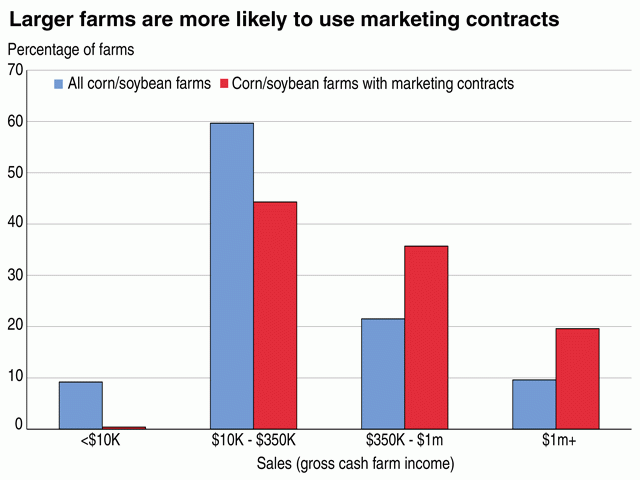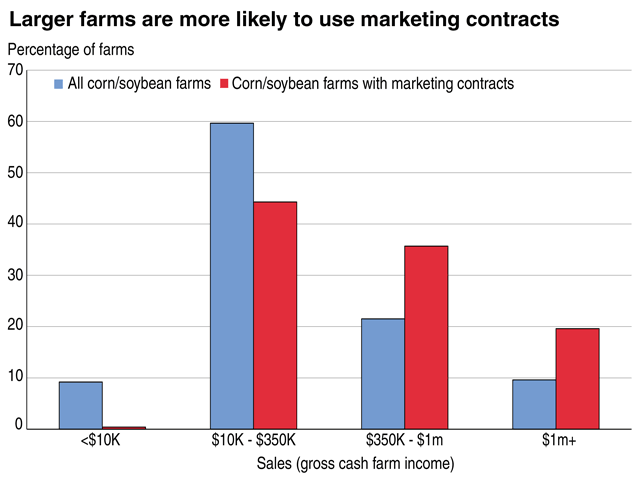Minding Ag's Business
Farmers Have a Lot of Marketing Tools Available, But What Do They Actually Use?
Over the past decade, I'd probably written more about grain marketing than any other subject. In those years I've learned that while some farmers love to follow the markets and use a lot of different tools to sell their grain, they are in the minority. I understand why some farmers would rather put their mental energy into production: they have more control over a greater number of pieces to that puzzle, although weather is always a wildcard.
When you can't set your price and the market moves on myriad factors beyond your control, it's easy to see why it slips down the priority list, even though it's an essential part of the business. There's no excitement, and very little joy, when your best sale of the year is, maybe, at breakeven prices.
A recent USDA report titled "Farm Use of Futures, Options and Marketing Contracts" explained a number of challenges farmers face when trying to manage their price risk. It also outlines a few characteristics of farmers that use many of these tools. The report, however, simply confirmed many of my suspicions rather than providing any new insights.
Scale is an important piece of the puzzle. Farmers with less than $350,000 in annual sales are less likely to use any kind of forward marketing. Futures and options contracts cover too many bushels as a percentage of production, and while cash contracts with local buyers offer more flexibility, they're not always practical if your sale periods are limited by your storage capacity.
Midsize ($350,000-plus annually) to large ($1 million-plus annually) farms are the major users of futures, options and marketing contracts. Marketing contracts are, by far, the most popular. USDA reports that slightly more than 156,000 farms used them to manage risk in 2016. For comparison, just over 47,000 farms used futures and options. While that represents about 2% of U.S. farms, the report notes these farms account for almost 11% of the total value of agricultural commodity production.
The vast majority of those using futures -- 94% -- grow corn and soybeans. (You can find a copy of that study here: https://www.ers.usda.gov/…)
P[L1] D[0x0] M[300x250] OOP[F] ADUNIT[] T[]
"That's partly because there is far more corn and soybean production, and there are far more corn and soybean farmers; over 300,000 farms grew corn or soybeans in 2016 (and most of them grew both), compared to about 95,000 that grew wheat, about 15,000 that grew cotton, and about 5,500 that grew rice," the report stated.
"But the incidence of futures and options use is also much higher among corn and soybean producers: for example, about 12% of corn and soybean producers used futures contracts, as compared to 5% of wheat growers, 4% of cotton producers, and 1% of rice growers."
Farmers that use futures and options strategies tend to be younger and more educated. According to the study, nearly 18% of college-educated corn and soybean farmers used futures, as did nearly 25% of operators below the age of 35. Options use was the highest among 35- to 44-year-old farmers. The study also found that operators with debt were more likely to use derivatives to manage risk than farmers without debt.
Surprised? Me neither. Younger farmers tend to have higher debt-to-asset ratios, and if you're borrowing money, the bank needs to know you have a plan to repay them, vis-a-vis a marketing plan. One common part of a marketing plan is selling portion of the crop before harvest, regardless of whether that's on exchange or with the local elevator.
Farmers age 65 and older are the least likely to use futures and options.
"Levels of educational attainment were not lower among operators over 65 than for farmers as a whole, so it may be that these operators have more assets and therefore can withstand a bad crop year without needing to hedge," the study's authors wrote.
The study found that farmers using forward sales, whether through cash contracts, futures or options, covered about 40% of their production using these tools.
"Farmers often use a portfolio of risk management tools," the report stated. "Those who use marketing contracts are much more likely to use futures and options than farmers who do not use marketing contracts. They are also more likely to invest in on-farm storage of their crops, which facilitates their ability to vary marketing volumes over time."
Two years ago, I profiled a young Iowa farmer who was an avid grain marketer, using various cash contracts, future and options. He told me he typically starts marketing the next year's crop before he finishes harvesting the current crop by using options. He starts adding sales through spring and summer, shifting into cash marketing contracts like hedge-to-arrive contracts and basis contracts, depending on which makes the most sense at the time. The goal is to provide downside protection while waiting for seasonal patterns and opportunities. You can find that story here: https://www.dtnpf.com/…
Maybe you're reading this right now from the cab of your combine, as autosteer guides you down a long row. Or maybe you're at the desk in your office because Mother Nature isn't cooperating and has you on the sidelines.
Regardless, rallies in the grain markets are unusual this time of year, and as DTN lead analyst Todd Hultman wrote last week, the corn market could be more bullish than we know (https://www.dtnpf.com/…). Even my dad, who doesn't farm but intently watches and trades a variety of markets, has been paying attention to soybeans. However, you choose to sell your crops, whatever work you have on your plate right now, it's a good time to be thinking about your grain marketing plans.
Katie Dehlinger can be reached at katie.dehlinger@dtn.com
Follow her on Twitter at @KatieD_DTN
(c) Copyright 2020 DTN, LLC. All rights reserved.






Comments
To comment, please Log In or Join our Community .